Prediction Technique and Measuring Device for Coupled Disturbance Forces from Large Equipment in the Spacecraft
Abstract
1. Introduction
2. Models for Measurement and Prediction
2.1. Mathematical Model for Measuring Dynamic Forces
2.2. Mathematical Model for Predicting Dynamic Forces
3. Structural Design of the Flexible Measuring Platform
3.1. Fundamental Structure
3.2. Structural Finite Element Analysis
4. Experimental Designs
4.1. Experimental Design for the Calibration
4.2. Experimental Design for the Terms in Mathematical Models
5. Experiment
5.1. Calibration Experiments for the Flexible Measuring Platform
5.2. Comparison of the Measurements of Platforms without Considering Coupling
5.3. Measurement of the Flexible Platform Considering Coupling
5.4. Experiment for Prediction of Disturbance Forces Considering Coupling
5.5. Application
6. Conclusions
Author Contributions
Funding
Data Availability Statement
Acknowledgments
Conflicts of Interest
References
- Sun, Y.; Deng, D.-S.; Yuan, H.-B. Precision of the Chinese Space Station Telescope (CSST) Stellar Radial Velocities. Res. Astron. Astrophys. 2021, 21, 092. [Google Scholar] [CrossRef]
- Miao, H.; Gong, Y.; Chen, X.; Huang, Z.; Li, X.-D.; Zhan, H. Cosmological Constraint Precision of Photometric and Spectroscopic Multi-Probe Surveys of China Space Station Telescope (CSST). Mon. Not. R. Astron. Soc. 2022, 519, 1132–1148. [Google Scholar] [CrossRef]
- Ji, X.; Deng, L.; Chen, Y.; Li, C.; Liu, C. The Study of Helium Variations in Star Clusters Using China Space Station Telescope. Res. Astron. Astrophys. 2023, 23, 075009. [Google Scholar] [CrossRef]
- Xie, W.; Chen, H.-L. Possibility of Searching for Accreting White Dwarfs with the Chinese Space Station Telescope. Res. Astron. Astrophys. 2022, 22, 055003. [Google Scholar] [CrossRef]
- Jiang, T.-L.; Wen, L.-H.; Zhan, H.; Wang, B.; Yang, Y.-C. Micro-Vibration Modeling and Verification of Shutter Mechanism of Survey Space Telescope. Res. Astron. Astrophys. 2023, 23, 015020. [Google Scholar] [CrossRef]
- Tang, L.; Zhang, K.; Guan, X.; Hao, R.; Wang, Y. Dynamic Modeling and Multi-Stage Integrated Control Method of Ultra-Quiet Spacecraft. Adv. Space Res. 2020, 65, 271–284. [Google Scholar] [CrossRef]
- Li, Y.; Yang, C.; Wang, G.; Zhang, H.; Cui, H.; Zhang, Y. Research on the Parallel Load Sharing Principle of a Novel Self-Decoupled Piezoelectric Six-Dimensional Force Sensor. ISA Trans. 2017, 70, 447–457. [Google Scholar] [CrossRef]
- Liu, J.; Li, M.; Qin, L.; Liu, J. Active Design Method for the Static Characteristics of a Piezoelectric Six-Axis Force/Torque Sensor. Sensors 2014, 14, 659–671. [Google Scholar] [CrossRef]
- Lee, Y.R.; Neubauer, J.; Kim, K.J.; Cha, Y. Multidirectional Cylindrical Piezoelectric Force Sensor: Design and Experimental Validation. Sensors 2020, 20, 4840. [Google Scholar] [CrossRef] [PubMed]
- Cheng, X.; Gong, Y.; Liu, Y.; Wu, Z.; Hu, X. Flexible Tactile Sensors for Dynamic Triaxial Force Measurement Based on Piezoelectric Elastomer. Smart Mater. Struct. 2020, 29, 075007. [Google Scholar] [CrossRef]
- Kim, K.; Kim, J.; Jiang, X.; Kim, T. Static Force Measurement Using Piezoelectric Sensors. J. Sens. 2021, 2021, 6664200. [Google Scholar] [CrossRef]
- Wang, Y.; Zuo, G.; Chen, X.; Liu, L. Strain Analysis of Six-Axis Force/Torque Sensors Based on Analytical Method. IEEE Sens. J. 2017, 17, 4394–4404. [Google Scholar] [CrossRef]
- Tamura, R.; Horikoshi, T.; Sakaino, S.; Tsuji, T. High Dynamic Range 6-Axis Force Sensor Employing a Semiconductor–Metallic Foil Strain Gauge Combination. IEEE Robot. Autom. Lett. 2021, 6, 6243–6249. [Google Scholar] [CrossRef]
- Tamura, R.; Sakaino, S.; Tsuji, T. High Dynamic Range Uniaxial Force/Torque Sensor Using Metal Foil and Semiconductor Strain Gauge. IEEJ Journal of Industry Applications. 2021, 10, 506–511. [Google Scholar] [CrossRef]
- Li, Y.-J.; Sun, B.-Y.; Zhang, J.; Qian, M.; Jia, Z.-Y. A Novel Parallel Piezoelectric Six-Axis Heavy Force/Torque Sensor. Measurement 2009, 42, 730–736. [Google Scholar] [CrossRef]
- Xia, M.; Zhou, C.; Zhang, E.; Han, C.; Xu, Z. A Dynamic Disturbance Force Measurement System Based on Array Sensor for Large Moving Device in Spacecrafts. J. Sound Vib. 2022, 535, 117069. [Google Scholar] [CrossRef]
- Zhou, S.; Sun, J.; Chen, W.; Li, W.; Gao, F. Method of Designing a Six-Axis Force Sensor for Stiffness Decoupling Based on Stewart Platform. Measurement 2019, 148, 106966. [Google Scholar] [CrossRef]
- Jia, Z.-Y.; Lin, S.; Liu, W. Measurement Method of Six-Axis Load Sharing Based on the Stewart Platform. Measurement 2010, 43, 329–335. [Google Scholar] [CrossRef]
- Wen, K.; Du, F.; Zhang, X. Algorithm and Experiments of Six-Dimensional Force/Torque Dynamic Measurements Based on a Stewart Platform. Chin. J. Aeronaut. 2016, 29, 1840–1851. [Google Scholar] [CrossRef]
- Zhou, C.; Xia, M.; Xu, Z. A Six Dimensional Dynamic Force/Moment Measurement Platform Based on Matrix Sensors Designed for Large Equipment. Sens. Actuators A Phys. 2023, 349, 114085. [Google Scholar] [CrossRef]
- Masterson, R.A.; Miller, D.W.; Grogan, R.L. Development and validation of reaction wheel disturbance models: Empirical model. J. Sound Vib. 2002, 249, 575–598. [Google Scholar] [CrossRef]
- Kim, D.-K. Micro-Vibration Model and Parameter Estimation Method of a Reaction Wheel Assembly. J. Sound Vib. 2014, 333, 4214–4231. [Google Scholar] [CrossRef]
- Xia, M.; Qin, C.; Wang, X.; Xu, Z. Modeling and Experimental Study of Dynamic Characteristics of the Moment Wheel Assembly Based on Structural Coupling. Mech. Syst. Signal Process. 2021, 146, 107007. [Google Scholar] [CrossRef]
- Addari, D.; Aglietti, G.S.; Remedia, M. Experimental and Numerical Investigation of Coupled Microvibration Dynamics for Satellite Reaction Wheels. J. Sound Vib. 2017, 386, 225–241. [Google Scholar] [CrossRef]
- Zhang, Z.; Aglietti, G.S.; Ren, W. Coupled Microvibration Analysis of a Reaction Wheel Assembly Including Gyroscopic Effects in Its Accelerance. J. Sound Vib. 2013, 332, 5748–5765. [Google Scholar] [CrossRef]
- Elias, L.; Miller, D. A Coupled Disturbance Analysis Method Using Dynamic Mass Measurement Techniques. In Proceedings of the 43rd AIAA/ASME/ASCE/AHS/ASC Structures, Structural Dynamics, and Materials Conference, Denver, CO, USA, 22–25 April 2002. [Google Scholar]






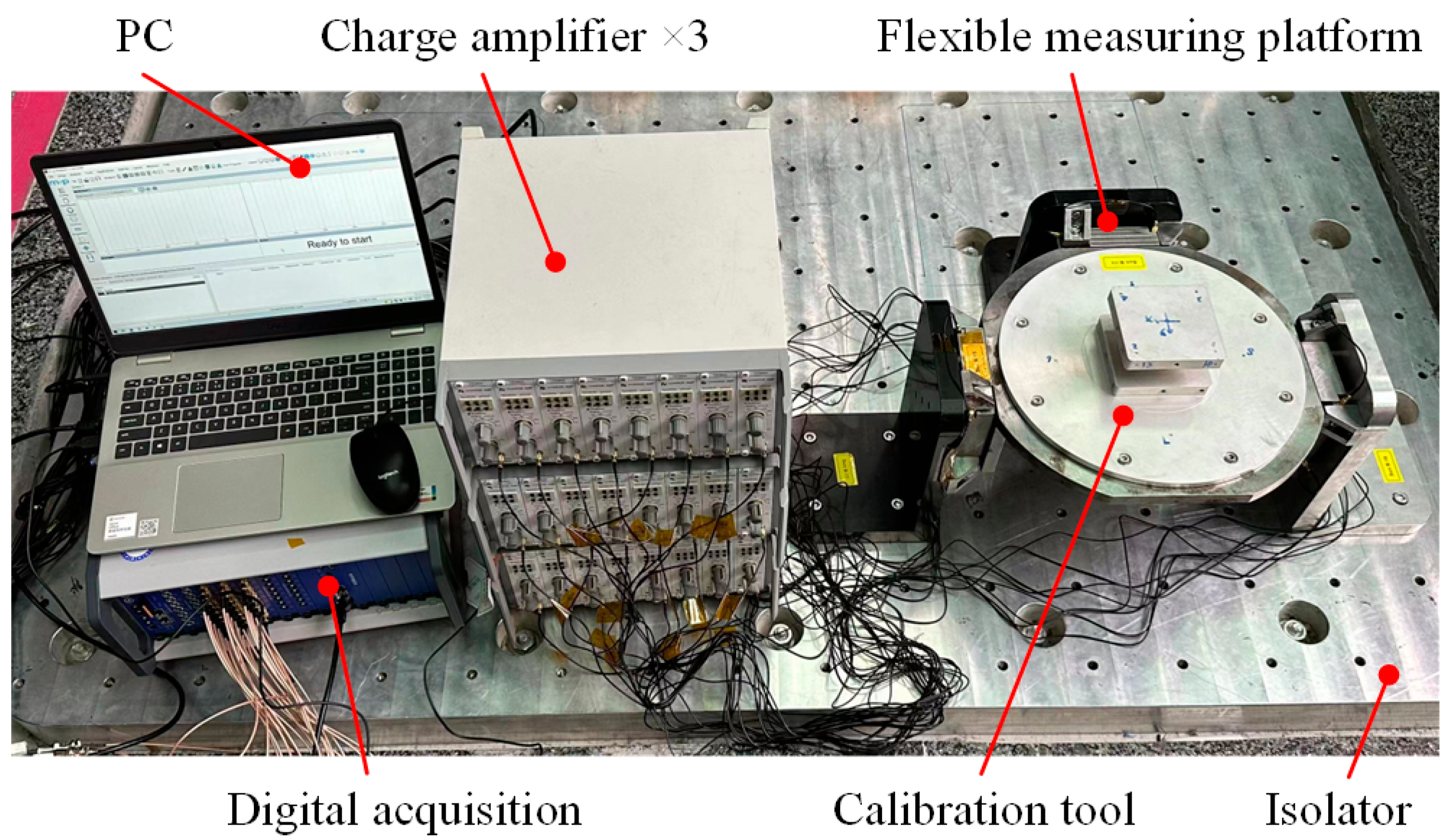
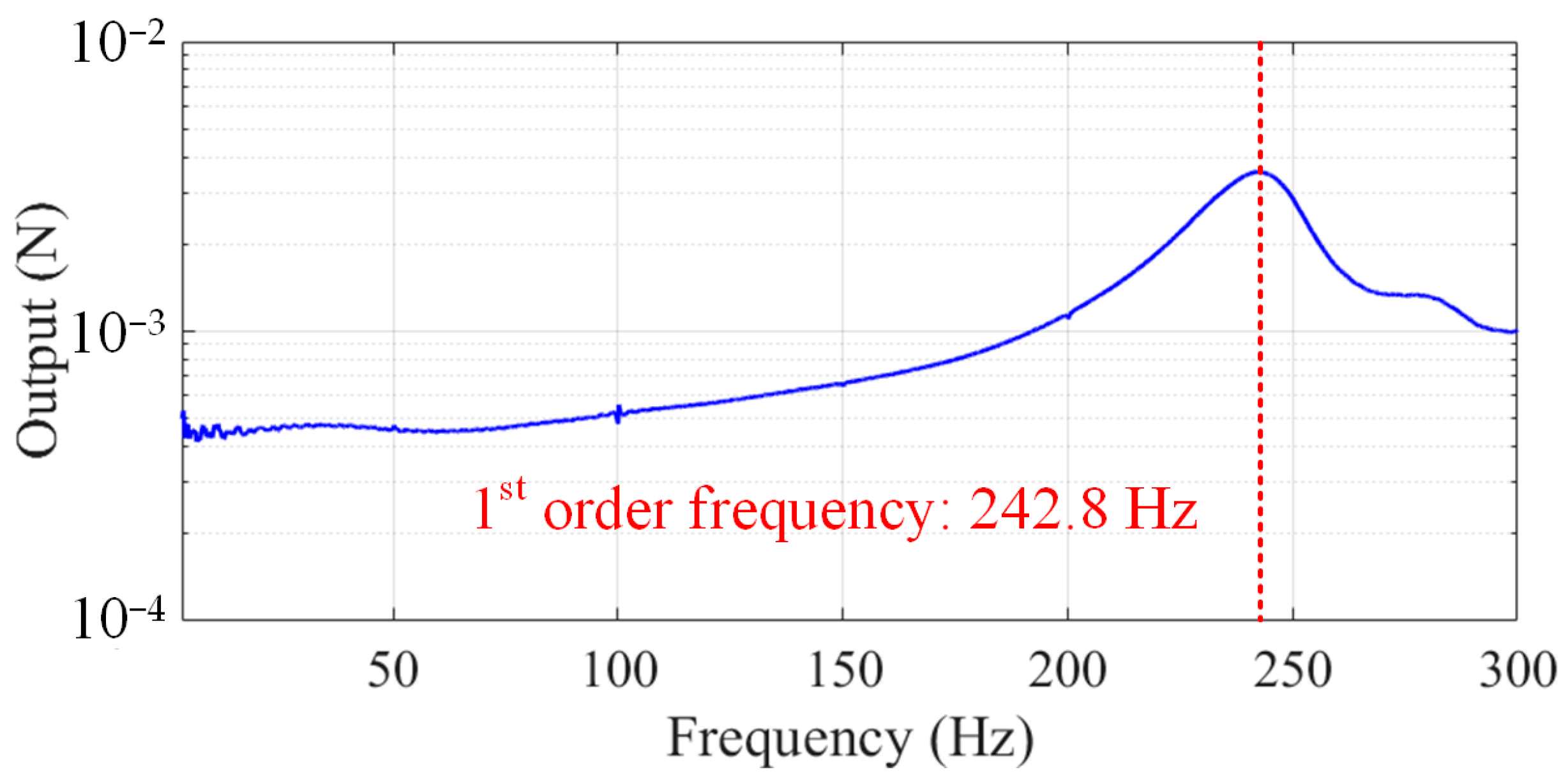



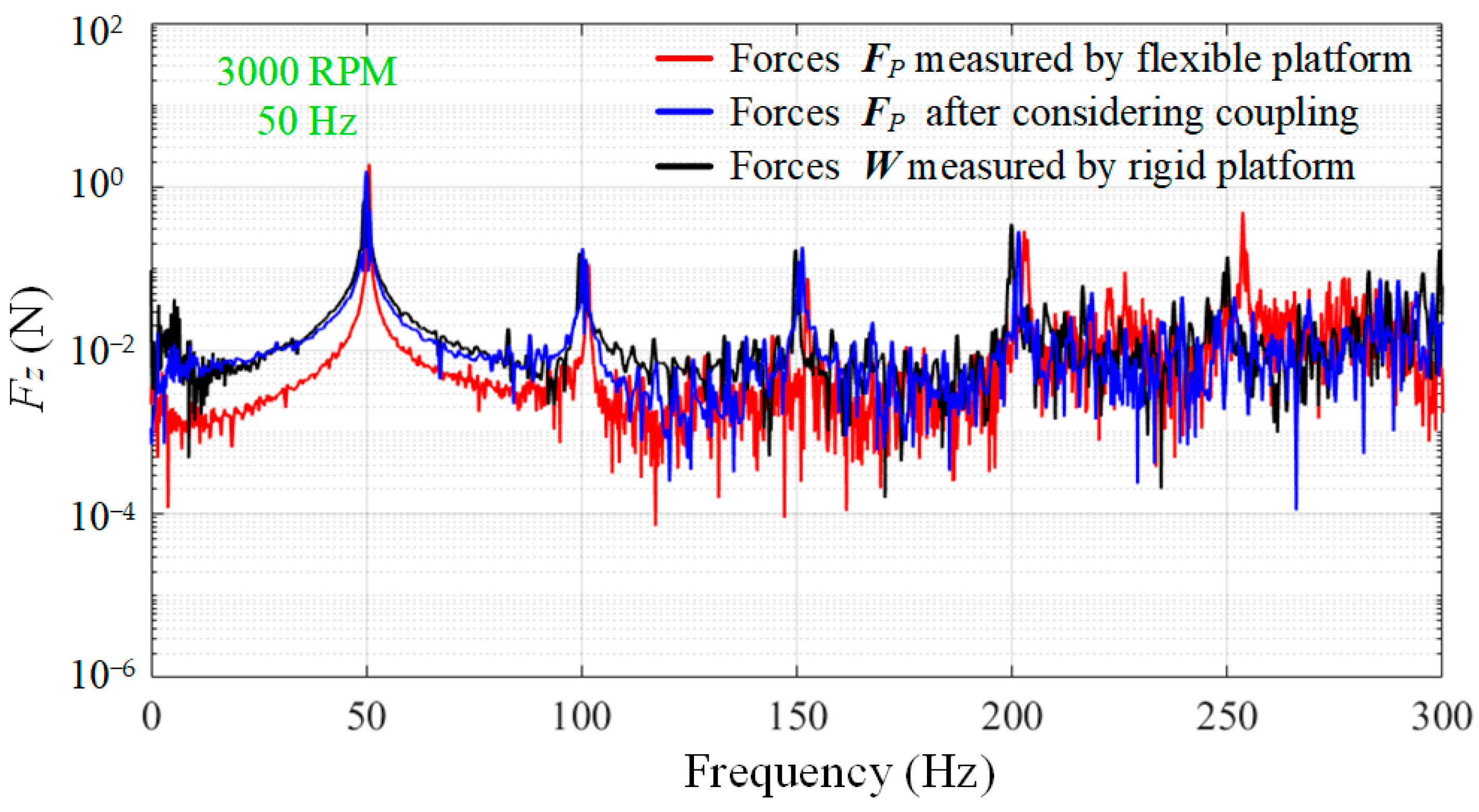
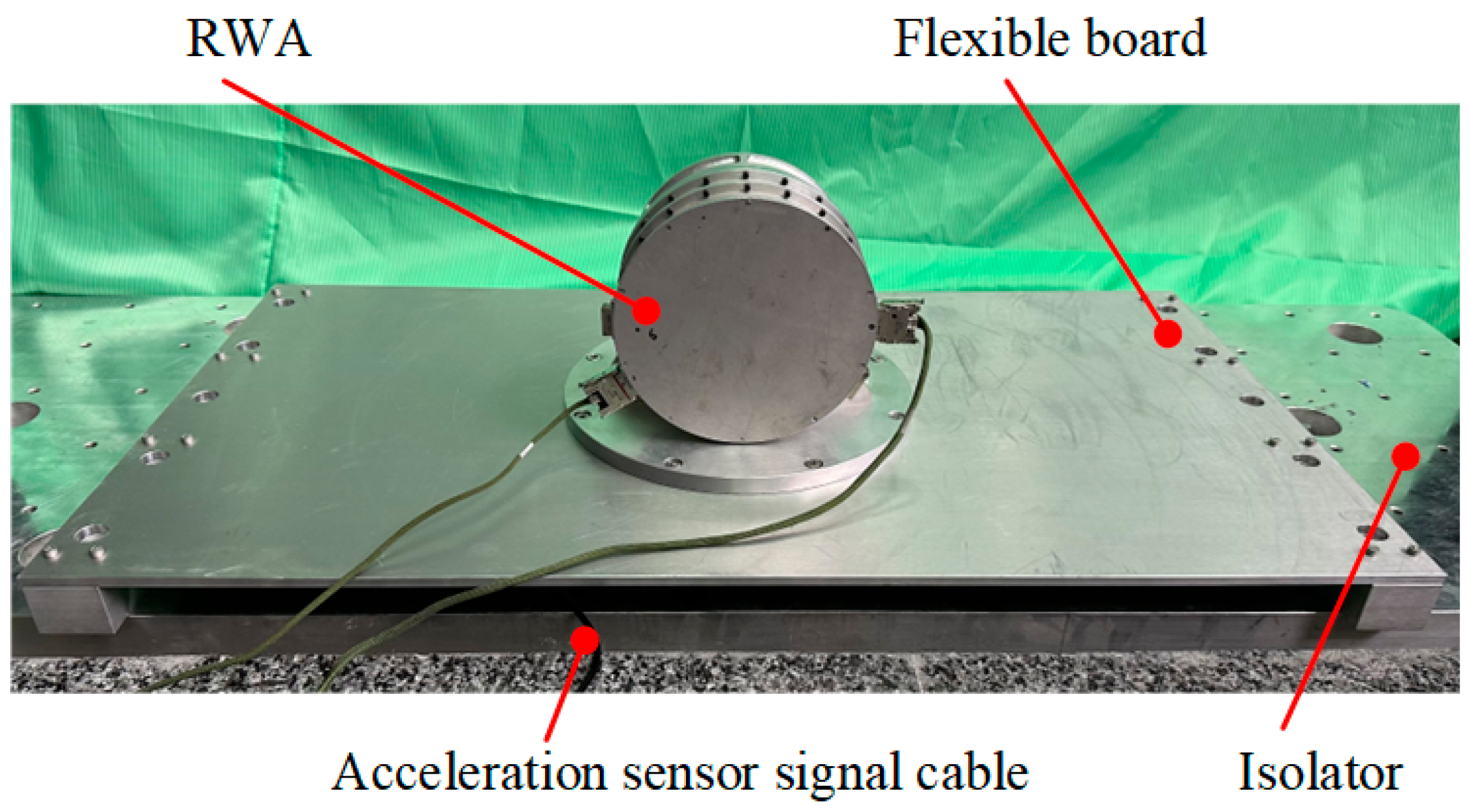
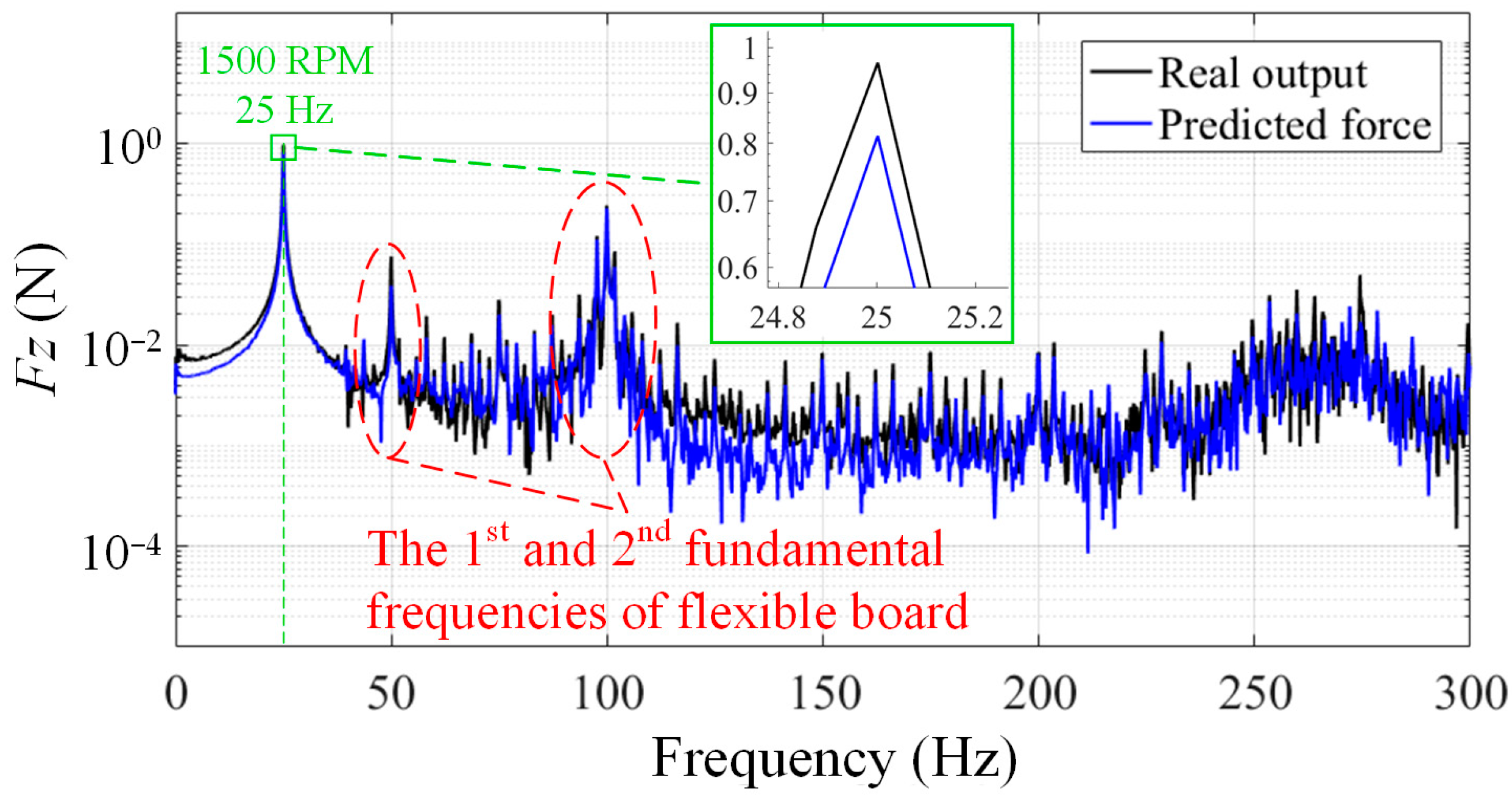
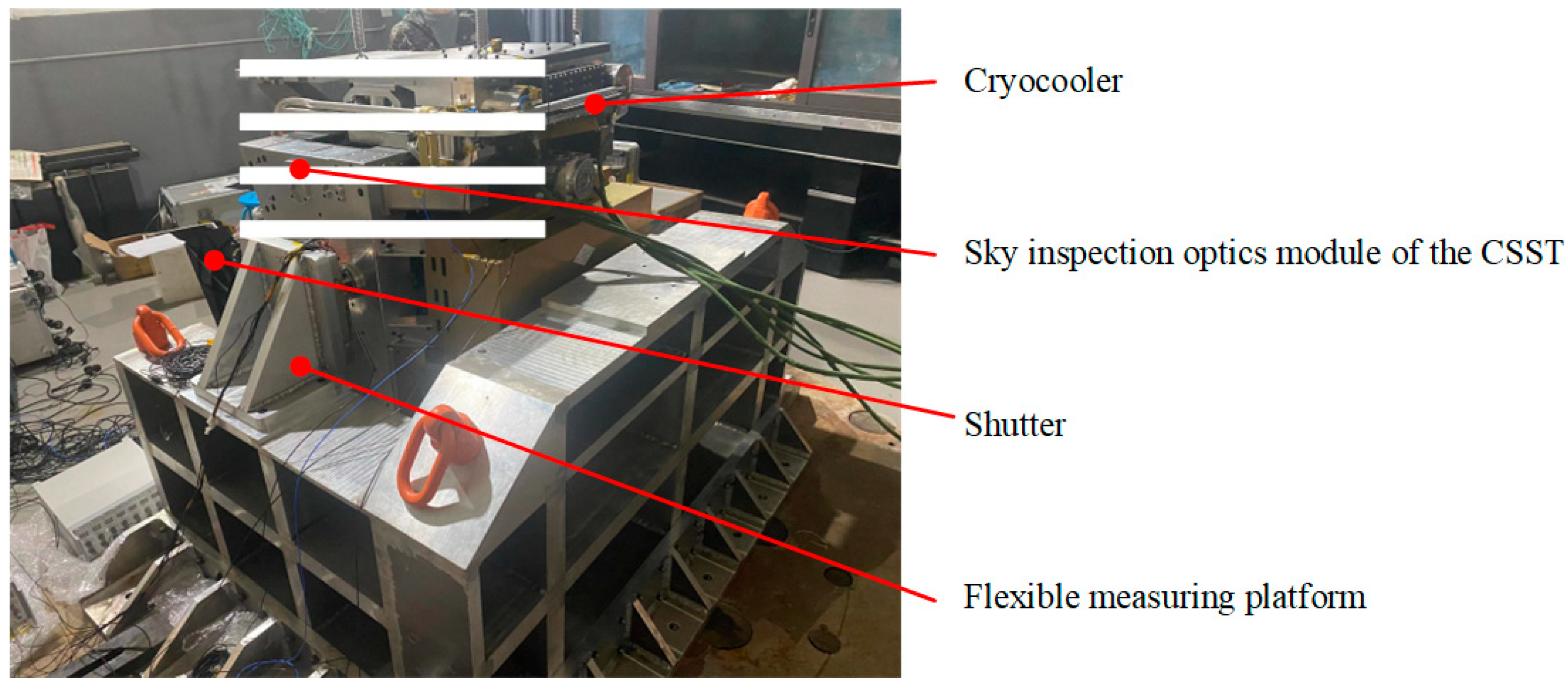
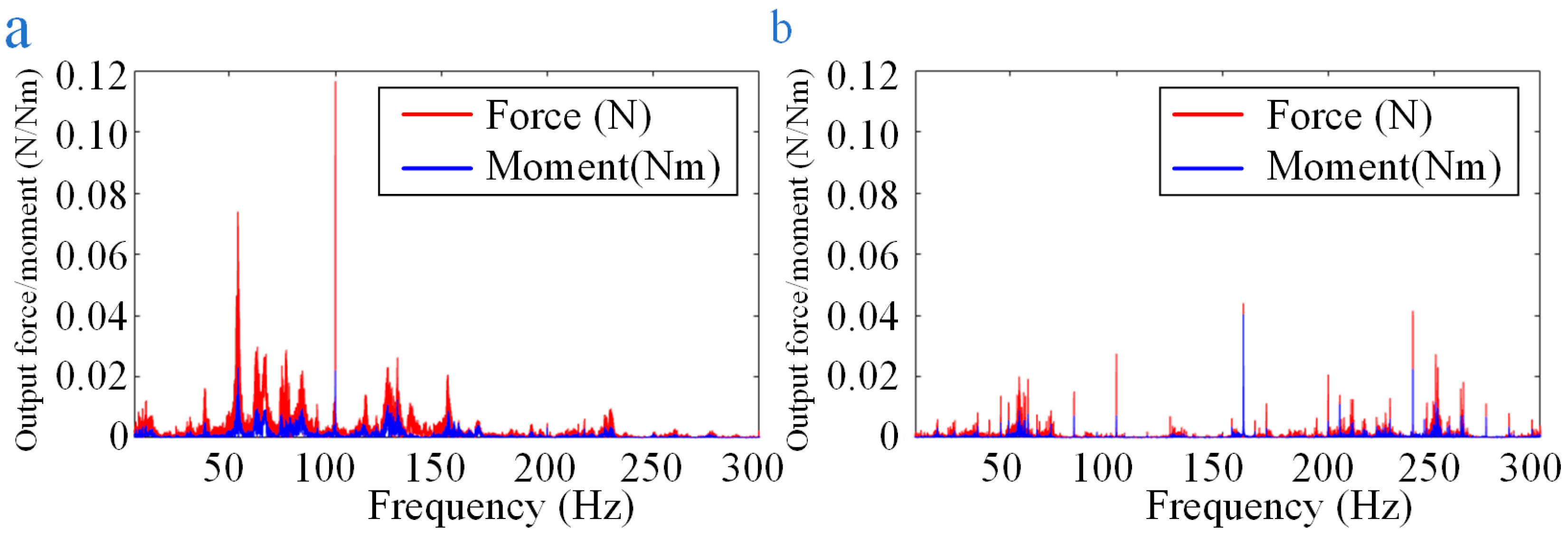
| No. | Model | Sensitivity | Range | Preload | Resolution |
|---|---|---|---|---|---|
| 1 | 9134B, Kistle | −3.8 pC/N | 26 kN | 15–25 Nm | — |
| 2 | 208C02, PCB | 11.241 mV/N | ±2224 N-pk | — | 0.004 N-rms |
| Component | E (MPa) | ν | ρ (kg/m3) |
|---|---|---|---|
| Installation plate, base, and tooling | 2.06 × 105 | 0.3 | 7.85 × 103 |
| Sensors (experimental acquisition) | 7.65 × 104 | 0.32 | 7.5 × 103 |
| Flexible board | 7.2 × 104 | 0.33 | 2.7 × 103 |
| Speed (RPM) | 3000 | 2500 | 2000 | 1500 | 1000 | 500 | ||
|---|---|---|---|---|---|---|---|---|
| Point 1 | Black line | Frequency (Hz) | 50.25 | 41.5 | 33 | 25.13 | 16.5 | 8.5 |
| Force (N) | 1.396 | 1.175 | 0.6374 | 0.3681 | 0.1884 | 0.0629 | ||
| Red line | Frequency (Hz) | 50.62 | 42.21 | 33.92 | 25.69 | 16.97 | 8.8 | |
| Force (N) | 1.902 | 1.383 | 1.672 | 1.276 | 0.24 | 0.0633 | ||
| Blue line | Frequency (Hz) | 50 | 41.92 | 33.08 | 25.15 | 16.41 | 8.33 | |
| Force (N) | 1.563 | 1.194 | 0.6126 | 0.3672 | 0.1705 | 0.0684 | ||
| Point 2 | Black line | Frequency (Hz) | 99.63 | 83.01 | 66.63 | —— | —— | —— |
| Force (N) | 0.1518 | 0.0525 | 0.0264 | —— | —— | —— | ||
| Red line | Frequency (Hz) | 101.6 | 84.67 | 67.71 | —— | —— | —— | |
| Force (N) | 0.1137 | 0.0462 | 0.0236 | —— | —— | —— | ||
| Blue line | Frequency (Hz) | 99.51 | 83.96 | 67.04 | —— | —— | —— | |
| Force (N) | 0.1554 | 0.0543 | 0.0214 | —— | —— | —— | ||
| Point 3 | Black line | Frequency (Hz) | 149.8 | 124.6 | —— | —— | —— | —— |
| Force (N) | 0.1696 | 0.0364 | —— | —— | —— | —— | ||
| Red line | Frequency (Hz) | 152.5 | 127 | —— | —— | —— | —— | |
| Force (N) | 0.0766 | 0.0453 | —— | —— | —— | —— | ||
| Blue line | Frequency (Hz) | 151.3 | 125.4 | —— | —— | —— | —— | |
| Force (N) | 0.1845 | 0.0311 | —— | —— | —— | —— | ||
| Point 4 | Black line | Frequency (Hz) | 199.9 | 166.9 | —— | —— | —— | —— |
| Force (N) | 0.3514 | 0.1073 | —— | —— | —— | —— | ||
| Red line | Frequency (Hz) | 202.9 | 169.5 | —— | —— | —— | —— | |
| Force (N) | 0.2901 | 0.1103 | —— | —— | —— | —— | ||
| Blue line | Frequency (Hz) | 200.9 | 167.5 | —— | —— | —— | —— | |
| Force (N) | 0.2891 | 0.0839 | —— | —— | —— | —— | ||
| Point 5 | Black line | Frequency (Hz) | 250 | 208.4 | —— | —— | —— | —— |
| Force (N) | 0.1405 | 0.1424 | —— | —— | —— | —— | ||
| Red line | Frequency (Hz) | 253.6 | 211.9 | —— | —— | —— | —— | |
| Force (N) | 0.4926 | 0.0464 | —— | —— | —— | —— | ||
| Blue line | Frequency (Hz) | 251 | 209.6 | —— | —— | —— | —— | |
| Force (N) | 0.0755 | 0.1373 | —— | —— | —— | —— | ||
Disclaimer/Publisher’s Note: The statements, opinions and data contained in all publications are solely those of the individual author(s) and contributor(s) and not of MDPI and/or the editor(s). MDPI and/or the editor(s) disclaim responsibility for any injury to people or property resulting from any ideas, methods, instructions or products referred to in the content. |
© 2024 by the authors. Licensee MDPI, Basel, Switzerland. This article is an open access article distributed under the terms and conditions of the Creative Commons Attribution (CC BY) license (https://creativecommons.org/licenses/by/4.0/).
Share and Cite
Zhou, C.; Xu, Z.; Xia, M. Prediction Technique and Measuring Device for Coupled Disturbance Forces from Large Equipment in the Spacecraft. Sensors 2024, 24, 1284. https://doi.org/10.3390/s24041284
Zhou C, Xu Z, Xia M. Prediction Technique and Measuring Device for Coupled Disturbance Forces from Large Equipment in the Spacecraft. Sensors. 2024; 24(4):1284. https://doi.org/10.3390/s24041284
Chicago/Turabian StyleZhou, Chengbo, Zhenbang Xu, and Mingyi Xia. 2024. "Prediction Technique and Measuring Device for Coupled Disturbance Forces from Large Equipment in the Spacecraft" Sensors 24, no. 4: 1284. https://doi.org/10.3390/s24041284
APA StyleZhou, C., Xu, Z., & Xia, M. (2024). Prediction Technique and Measuring Device for Coupled Disturbance Forces from Large Equipment in the Spacecraft. Sensors, 24(4), 1284. https://doi.org/10.3390/s24041284






